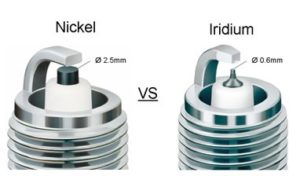
Why Design Precious Metal Spark Plugs?
The engineering design motive behind Precious Metal ‘tipped’ spark plug electrodes was solely performance driven. The precious metal tipped centre electrode allows the Centre Electrode Diameter to be reduced to 0.6mm, which is dramatically smaller than standard nickel alloy spark plugs, with a CED of 2.5mm. By creating a smaller centre electrode, higher ignitability is gained resulting in optimal fuel efficiency and greater power. In addition, further enhancements achieved by incorporating Precious Metal to a Spark Plug were superior durability and reliability, resulting in prolonged service life, leading to 100,000km - 120,000km standard replacement intervals.
By reducing the Centre Electrode Diameter of a standard Nickel-Alloy Spark Plug, although easily done, would result in a very limited and unacceptable service life.
Why Iridium and Platinum metals?
Iridium and Platinum have been selected as the materials of choice for tipping the centre electrodes of NGK Spark Plugs due to their high melting points and oxidation starting temperature attributes.
High Melting Point: Able to withstand the high temperatures of burning air/fuel mixtures
Oxidation Starting Temperature: The temperature which electrode oxidation (electrode wear) begins. The higher the number, the slower the rate of electrode wear resulting in longer service life
A combination of these two key attributes results in the materials been resistant to wear (gap growth) when exposed to the harsh environment within the combustion chamber.
What vehicles use Precious Metal Spark Plugs?
Eight of the ‘Top 10’ vehicles sold in Australia have Precious Metal Spark Plugs installed, with NGK being the OE supplier for the majority of them. The decision to change from Nickel to Precious Metal was a response to the increasingly strict vehicle emission regulations that have been legislated by influential Federal Governments. Derived from these regulations, pressure on all Global vehicle manufacturers to reduce harmful emissions and improve fuel efficiency has intensified.
NGK’s OE engineers work closely with all vehicle manufacturers to develop unique Precious Metal Spark Plugs that are specific for each of their vehicle applications, and adhere to the performance and emission guidelines. These Spark Plugs possess superior ignitability over conventional Nickel Spark Plugs, and assist vehicle manufacturers to meet and exceed modern day regulations that are mandatory.
What Precious Metal Spark Plug range trends should be avoided?
In recent times within the aftermarket, there has been a push for a consolidated range of Precious Metal Spark Plugs which can cover most of the popular vehicle applications in Australia. This consolidated range compromises many Spark Plug attributes which are vital for maintaining optimal performance of your engine which include:
Heat range
Firing end projection
Number of ground electrodes
Ground electrode shape/design
Single/double precious metal and Double Fine Electrode (DFE)
Vehicle manufacturers spend years developing engines, and the recommended Spark Plug attributes have been selected to ensure the engine performs to its peak performance and emission design requirements. All NGK Spark Plug listings match OE specifications to ensure optimal performance and reliability. Even though many plugs with similar part numbers may look the same, each part number has its own characteristics, with some changes not physically visible. These differences are imperative to the operation of the engine and straying from the recommended plug can result in some loss of performance or even severe engine damage.
For peace of mind, always ensure you use a plug recommended to meet the OE specification. This will avoid any damage and ensure peak performance of your vehicle. Don’t just ask for a plug, insist on NGK!